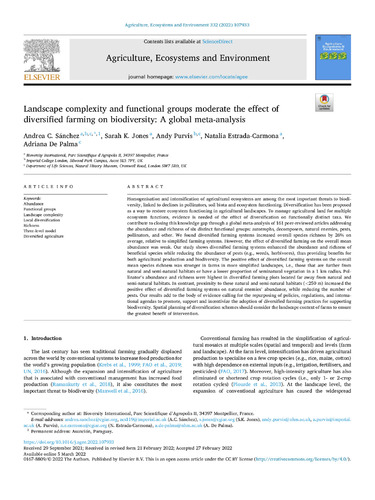Landscape complexity and functional groups moderate the effect of diversified farming on biodiversity: A global meta-analysis
Homogenisation and intensification of agricultural ecosystems are among the most important threats to biodi versity, linked to declines in pollinators, soil biota and ecosystem functioning. Diversification has been proposed as a way to restore ecosystem functioning in agricultural landscapes. To manage agricultural land for multiple ecosystem functions, evidence is needed of the effect of diversification on functionally distinct taxa. We contribute to closing this knowledge gap through a global meta-analysis of 161 peer-reviewed articles addressing the abundance and richness of six distinct functional groups: autotrophs, decomposers, natural enemies, pests, pollinators, and other. We found diversified farming systems increased overall species richness by 26% on average, relative to simplified farming systems. However, the effect of diversified farming on the overall mean abundance was weak. Our study shows diversified farming systems enhanced the abundance and richness of beneficial species while reducing the abundance of pests (e.g., weeds, herbivores), thus providing benefits for both agricultural production and biodiversity. The positive effect of diversified farming systems on the overall mean species richness was stronger in farms in more simplified landscapes, i.e., those that are further from natural and semi-natural habitats or have a lower proportion of seminatural vegetation in a 1 km radius. Pol linator’s abundance and richness were highest in diversified farming plots located far away from natural and semi-natural habitats. In contrast, proximity to these natural and semi-natural habitats (<250 m) increased the positive effect of diversified farming systems on natural enemies’ abundance, while reducing the number of pests. Our results add to the body of evidence calling for the repurposing of policies, regulations, and interna tional agendas to promote, support and incentivize the adoption of diversified farming practices for supporting biodiversity. Spatial planning of diversification schemes should consider the landscape context of farms to ensure
the greatest benefit of intervention.

